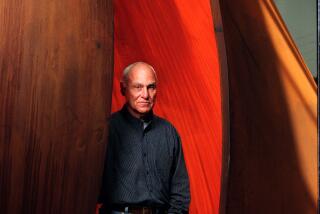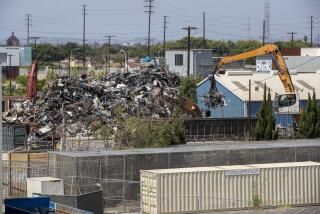Sheet Metal Is Starting to Shine
- Share via
Once relegated to the dark innards of buildings, sheet metal is increasingly taking its place in the sun.
Its use as a central design element has ratcheted up in the last few years, industry experts say, as construction recovers from a slowdown after the 9/11 attacks and the metallic vision of a certain iconic L.A. architect spreads.
“You can look at all the buildings Frank Gehry has designed and created and see how popular metal has become,” said Rosalind Raymond, spokeswoman for the Sheet Metal and Air Conditioning Contractors’ National Assn., referring to the designer of Walt Disney Concert Hall in Los Angeles.
The sheet metal market has expanded rapidly, growing 9.7% a year, on average, from 2002 to 2005, when manufacturers chalked up $15 billion in sales to contractors and other customers. That comes after a 1% average annual growth rate in the five previous years, according to Catalina Research Inc.
Architectural sheet metal, the type used to clad and roof buildings rather than to line ducts or form automobiles, constitutes a quarter of the market, the research firm said.
“L.A. is the land of stucco, so give me anything that’s not stucco,” said architect Lawrence Scarpa, adding that sheet metal’s low maintenance and often high recycled content has increased its appeal. His Santa Monica-based firm, Pugh & Scarpa Architects, works frequently with metal.
The major beneficiaries of metal’s rising popularity: contractors who specialize in its architectural uses.
Orange-based architectural sheet metal contractor CMF Inc., which installed a “skin” of aluminum around Staples Center and 4,000 stainless-steel panels on Disney Concert Hall, said it had seen the number and size of its projects soar.
The bulk of the company’s projects in 2000 averaged $100,000 or less, said Dave Duclett, co-owner with founder Paul Keohane. Its current roster of present and future jobs includes 15 projects of at least $1 million and several that easily top that figure.
“The use of sheet metal in buildings is taking off,” said Duclett, whose company is one of the largest sheet metal contractors in Southern California. “It’s like styles of clothing that go in and out of fashion over the years. I think metal is really coming into its own.”
Cimco AC & Sheet Metal Inc., in Santa Fe Springs, has seen a 10% to 20% increase in business the last five years. Gardena-based Weiss Sheet Metal has noticed an uptick in the call for architectural sheet metal too.
A recent construction boom has fueled demand, leading to potential growth of 10% to 15% this year for Weiss, said Andre Sarai, the company’s president. The pluses of building with metal play a role too, he said.
“Metals tend to last longer, and there’s less maintenance,” he said. “And aesthetically, they are very pleasing.”
Architectural sheet metals have come a long way since they first came into wide use around the turn of the last century, when they were used mainly to waterproof buildings and to add ornamental incidentals like cornices and cupolas.
Architects and contractors say metals now take center stage in an increasing number of projects.
They come in a broad range of materials, including the familiar aluminums, coppers, zincs and stainless steels, as well as newer alloys and composites.
Proponents point out that modern technology has allowed metal to take on previously unimaginable forms. Metal can be wrinkled to resemble leather, baked with enamel to create color or chemically treated to age it. Its shine and shape can be manipulated as well.
“You can do a million things to metal depending on how you treat it,” said Bill Blackstone, a technical consultant to the Los Angeles chapter of the sheet metal contractors group.
Architect Brent Eckerman, principal of Frederick Fisher & Partners Architects in Los Angeles, said in the last five years he had worked with an increasing number of projects that call for metal -- and seen other architects catch on to it too.
“It used to be it was only put on hangars and sheds and that sort of thing,” he said, “but it’s sort of a trendy material now.”
Metal’s durability works in its favor, he said, as do the creative possibilities it allows. For example, Cor-Ten steel, a slow-to-rust alloy that Eckerman is using to clad a Santa Barbara house, creates a rusty, aged look. A corrugated metal can create a more industrial look, he said.
Clients’ growing comfort with the material also may be boosting its visibility, said David Montalba of Santa Monica-based Montalba Architects Inc.
Perhaps 10 years ago, he said, clients would have less of an appreciation for using metal.
“Most clients are comfortable with what they’ve seen before. And now that they’re seeing it quite a bit, it’s becoming common that they’re comfortable with it.”
Architectural sheet metal isn’t cheap, and those who work with it point out that recent increases in the price of raw materials have driven up costs even more.
“Every two weeks I get an increase,” said Wayne Chambers of Coast Sheet Metal Inc. in Costa Mesa. Chambers estimated that his raw materials costs have jumped by a third this year in large part because of increases in the price of copper, which hit an all-time high last month.
Scarcity is a reason for the price increases, as is China’s building boom and its simultaneous cutback in metal production, metal distributors said.
But projects in which metal will play a starring role are still going forward around the region.
Construction has begun in downtown Los Angeles on the Nokia Theatre, part of a $1.5-billion entertainment and hotel complex going up across the street from Staples Center. CMF will clad the theater in 85,000 square feet of metal paneling.
Irvine-based Atlas Sheet Metal Inc. will create yet more shiny baubles when it clads or roofs 10 schools and 40 custom homes in the stuff this year.
Atlas President Jim Odlum took a stab at explaining metal’s appeal.
“It’s something different and modern looking, you know?” he said. “It’s a beautiful material.”
More to Read
Inside the business of entertainment
The Wide Shot brings you news, analysis and insights on everything from streaming wars to production — and what it all means for the future.
You may occasionally receive promotional content from the Los Angeles Times.










